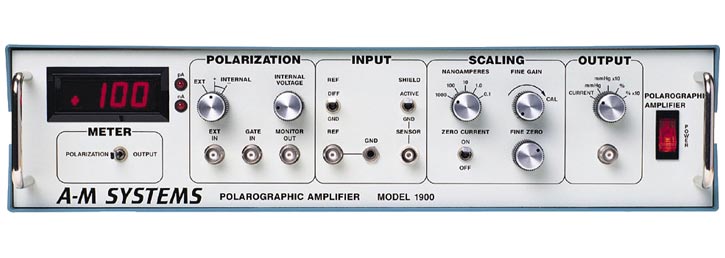Model 1900
Designed for low-noise, precise amperometric measurements with a range of commercial polarographic oxygen sensors.
Sensors: Hydrogen & Oxygen
Wide Response Range: 0.1 nA to 1,000 nA
Excellent Resolution: to 0.1 pA
The Model 1900 Polarographic Amplifier has been specifically designed for low noise, precise amperometric measurements. The features of this research instrument easily permit the use of a wide range of polarographic oxygen or hydrogen sensors.
Features
- Low noise
- Can use both Hydrogen and Oxygen sensors
- Wide response range
- Excellent resolution
- Full scale digital panel meter displays current, mm Hg, x10, %, and %x10 outputs
- Internal/external gateable electrode polarization
- Single-ended or differential measurement
The wide response range of the Model 1900 extends all the way from 100 pA up to 1 uA with 100% overrange on all scales. On its most sensitive scale, the resolution is 0.1 pA. The amplifier output is displayed on the front panel digital meter, and is available from a BNC connector for chart recorders, polygraphs, A/D converters or other display devices. Accuracy, ease-of-use, and recording flexibility are design features for the researcher’s satisfaction.
No headstage is required to achieve the 0.1 pA sensitivity, reducing the congestion at the electrode measurement site. The input connections are made conveniently through standard BNC connections. The front panel scale adjustment does not require zero current readjustment when there is a change in scale, reducing instrument set-up time. The digital meter display is switch selectable for mmHg, percent (x1 or expanded x10), or absolute current. The instrument gain automatically adjusts for polarity of the polarization voltage, even for an external polarization input.
The maximum input bias current is less than 1 pA at normal room temperature. With the 10-turn potentiometer knob, the Zero Current control can be used to eliminate this input bias current of the polarographic sensor at 0% oxygen. The Zero Current can be turned off to determine the absolute current level. This is a convenient way to check electrode resistance.
The amplifier offers two polarization voltage methods. One is from the instrument’s internal source set by the Internal Voltage knob; the other is from an external source into the Ext In BNC connector. A novel feature for the external source is that a variety of polarization waveforms may be used. The display meter can be switched to monitor the polarization voltage. The voltage can also be monitored via the Monitor Out BNC connector. An external GATE signal may be used to switch on or off the polarization voltage applied to the electrode, for further experimental control.
The Model 1900 has been designed to minimize the effects of artifacts and noise. While for many applications a single-ended sensor input may be adequate, differential measurements may also be made. Built-in low pass and notch filters further reduce spurious noise. The instrument has features to withstand the rigors of a research environment, with protection against normal static or DC overvoltages.





